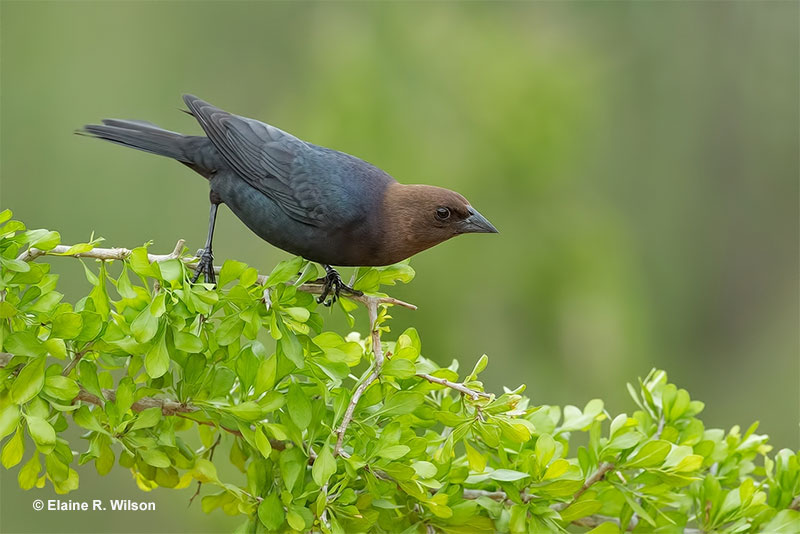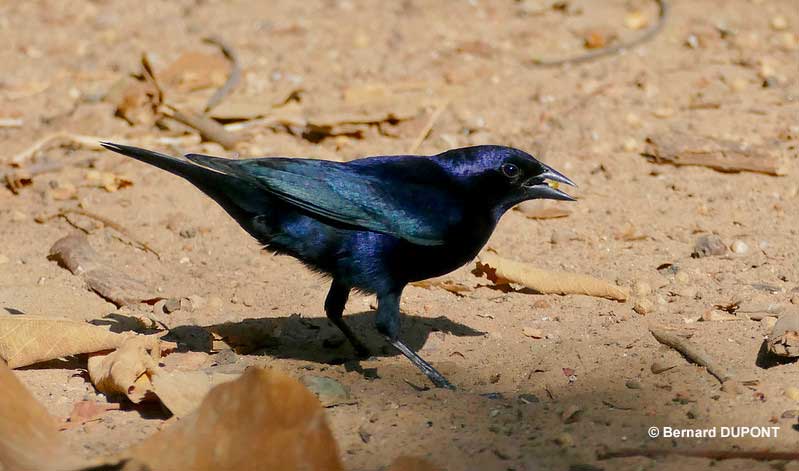The Brown-headed Cowbird (Molothrus ater) is a smallish, black bird with a brown head, or a pale brown bird with a short beak, and short tail.
If you see small blackbirds with brown heads, or pale brownish, finch-like birds with pale throats in parks, lawns, and other open places, you are probably seeing this species.
Did you know that Brown-headed Cowbirds act like cuckoos? Having evolved to follow nomadic Bison around, they lay their eggs in nests of cardinals, warblers, and lots of other small birds.
Learn more about this common, interesting species below!
On this page
Identification
The male Brown-headed Cowbird is a smallish songbird with a black body and a dark brown head. In certain lighting, its plumage shows glossy, dark blue highlights. It also has a short, finch-like bill, a fairly short tail, and black legs and feet.
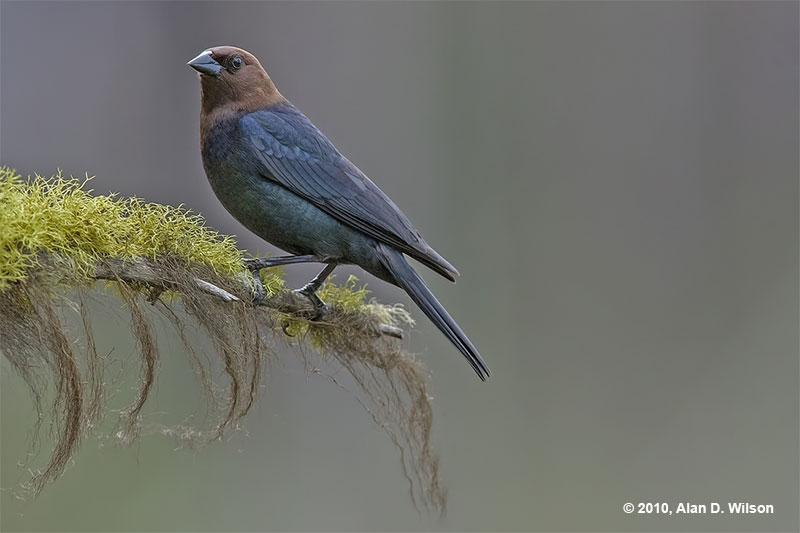
On average, this species is 7.5 inches long, has a wingspan of 12 inches, and weighs 1.5 ounces. Female Brown-headed Cowbirds look so different from the males, when people see them, many have no idea what it is!
They are pale, plain grayish-brown birds with a pale throat and usually, a pale eyebrow. They can also have indistinct streaking below and a faint, dark mark on each side of their throat.
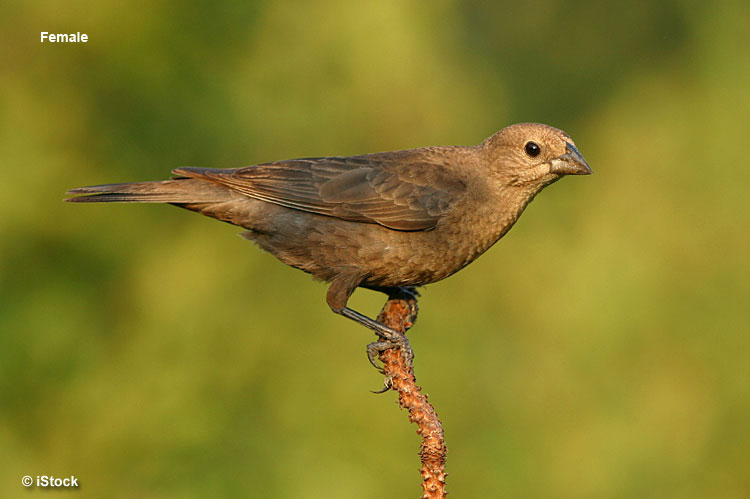
Young birds look like females but have fine streaking below, pale spectacles, and a pale scaled pattern on their backs. There are also juvenile birds molting into adult plumage that are pale gray-brown with black patches.
Brown-headed Cowbirds fly with a burst of rapid wingbeats followed by briefly holding their wings closed. Their quick, undulating flight looks as if they are bouncing up and down in the air.
This species is fairly vocal and both sexes often make a high-pitched rattling call. Males also sing a brief, bubbling, high-pitched song that sounds like glug glug kleee.
Food
Brown-headed Cowbirds eat small seeds and a variety of insects. During the breeding season, females also eat small snails and can also feed on egg shells in the nests that they parasitize.
Most of this bird’s diet are seeds from “weedy” plants that grow in all sorts of pasture, the edges of roads, vacant lots, and other grassy habitats. They feed on seeds by walking and using their beak to pick them up from the ground.
However, they won’t feed in any suitable-looking spot. They much prefer to associate with and feed near horses, cows, and Bison. For this reason, one of the most reliable places to see a Brown-headed Cowbird is on a farm or in open fields where these large animals are grazing.
These blackbirds also forage for insects in the same situations. During the breeding season, grasshoppers, beetles, and other arthropods make up 25% of their diet, and they also catch them by foraging on the ground. Once in a while, Brown-headed Cowbirds also fly into the air to snatch an insect, especially when big grazing animals scare bugs out of hiding.
The Brown-headed Cowbird often forages alone, but they usually occur in flocks of a dozen or so birds. They are also regular at bird feeders.
Nesting and Eggs
Unlike most small birds, Brown-headed Cowbirds don’t build a nest and they don’t care for their young. But how is this possible? How can a bird not build a nest, not care for its young but still manage to survive?
The only way to do this is by letting another bird do all of the work. Instead of making a nest and feeding their young, female Brown-headed Cowbirds lay their eggs in the nests of other bird species. In other words, this species is a nest parasite.
They probably evolved this behavior because, in following Bison around, they didn’t have time to build their own nest.
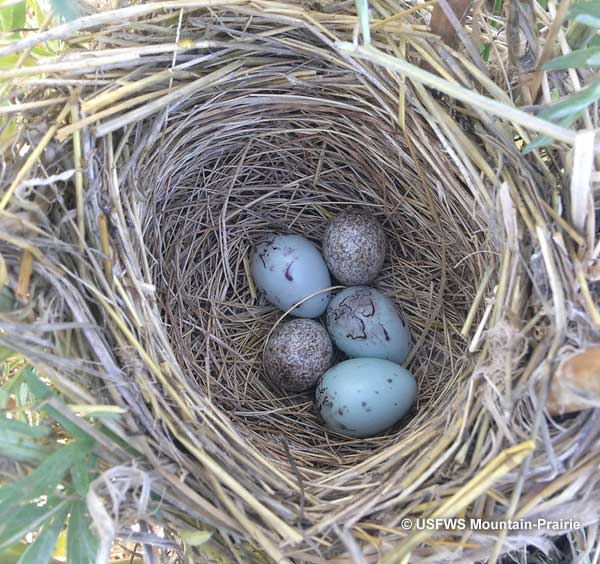
Brown-headed Cowbird eggs in a Red-winged Blackbird‘s nest. © USFWS Mountain-Prairie
Brown-headed Cowbirds can parasitize all sorts of species, but they typically pick birds that lay smaller eggs than the cowbird does.
She lays six, white or gray-blue eggs with red-brown markings, each one in a different nest, often after removing one of the eggs of the host species.
The host incubates her egg and it hatches after ten days. Host birds then feed the young cowbird, often to the detriment of their own babies, and the cowbird nestling leaves the nest after ten days. The baby continues to be fed by the host until it becomes independent at 25 to 30 days of age.
Current Situation
The Brown-headed Cowbird lives in much of Canada, and throughout the lower 48 states south into Mexico. These birds are especially common on farms and areas with cattle but they can also be seen in parks, suburban areas, and just about any type of open habitat.
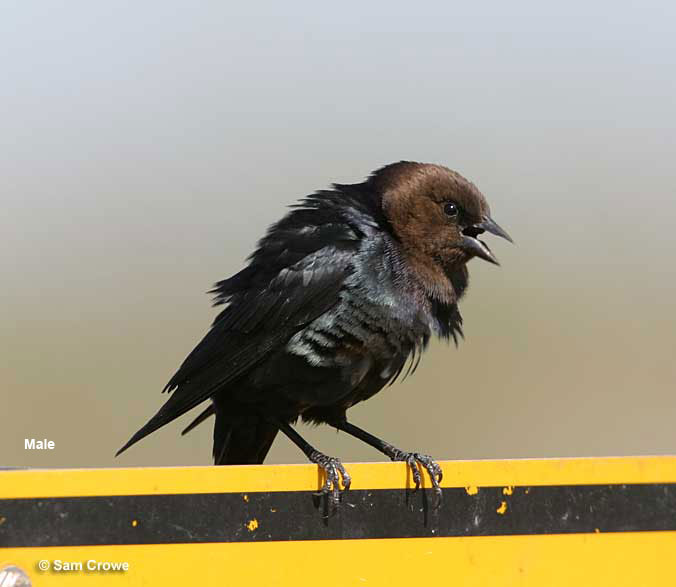
They are listed as Least Concern in the IUCN Red List and are a common to abundant bird throughout their range.
Brown-headed Cowbirds are common and easy to see, especially in farming areas.
Although these birds were historically associated with Bison on the Great Plains, once they became adapted to cows and horses, their population exploded.
In present times, 20 to 40 million Brown-headed Cowbirds are estimated to live in North America and they are not threatened in any way.
In places where their parasitism can affect the Kirtland’s Warbler and other threatened species, Brown-headed Cowbirds are legally trapped and euthanized.
Facts
- Brown-headed Cowbirds have been documented using the nests of 220 bird species! They mostly parasitize nests of 50 species, the most frequent ones being Yellow Warblers, Song Sparrows, Red-eyed Vireos, and Chipping Sparrows. An individual female cowbird also typically specializes in laying her eggs in the nests of one particular species.
- To find a suitable host, the female Brown-headed Cowbird watches for nest-building activity from the top of a bush or tree, or from open ground. She can also perch near a possible nest and hope to attract the nesting bird by flapping her wings. When the female host species flies in to chase away the threat, the cowbird can fly in to the exposed nest and lay her egg.
- Not every bird accepts a cowbird egg. When some small species like the Yellow Warbler recognize a cowbird egg, they build a new nest on top of the old one. Other birds can destroy or throw out cowbird eggs but most birds just don’t recognize the foreign egg and end up raising the baby cowbird.
Similar Species
The Brown-headed Cowbird is a pretty distinctive species. However, it is sometimes confused with a few other birds.
Bronzed Cowbird
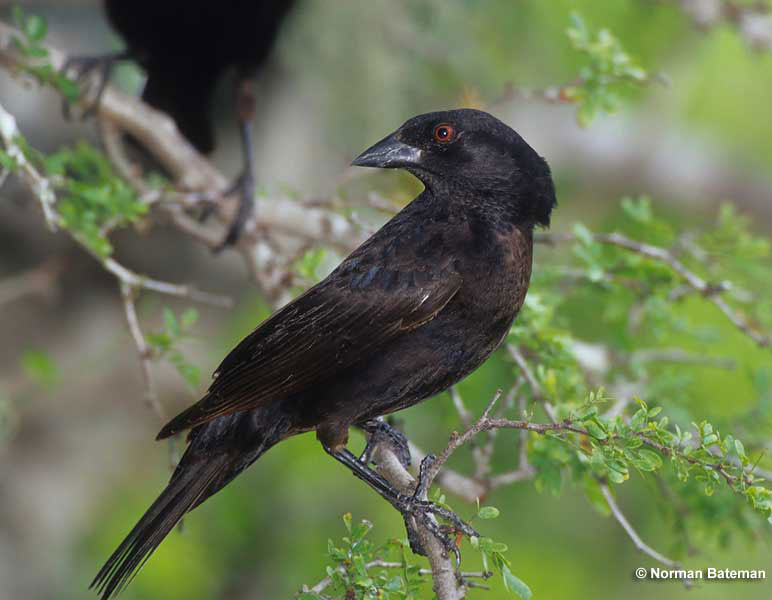
Bronzed Cowbirds are somewhat similar size and shape and occur in the same areas, but they don’t have a brown hood.
Females can look especially similar, but the Bronzed Cowbird tends to have dark, contrasting wings. Both sexes of the Bronzed Cowbird also have red eyes and slightly heavier beaks than the Brown-headed Cowbird.
Shiny Cowbird
The Shiny Cowbird mostly lives in southern Florida but occasionally shows up in other spots too. The male lacks a brown hood and is thus easily separated from the Brown-headed Cowbird.
Females and juveniles, though, can look very similar. They can be separated from Brown-headed Cowbirds by their more uniform brown plumage and a thinner, sharper beak.
Brewer’s Blackbird
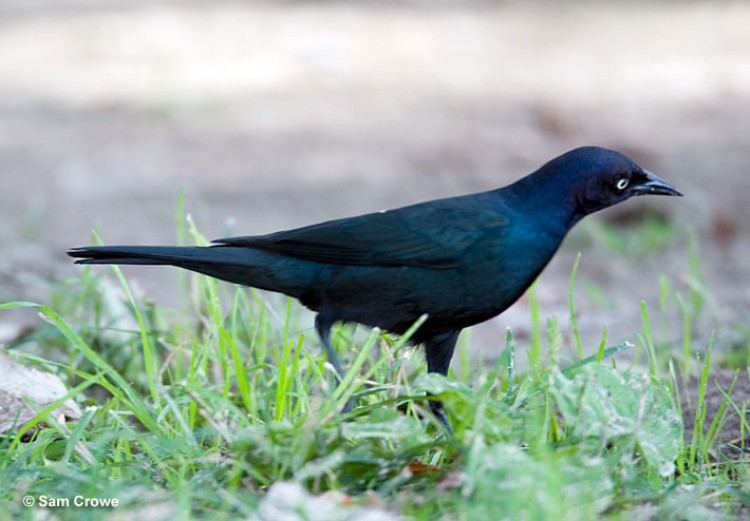
Brewer’s Blackbirds can flock with Brown-headed Cowbirds, and males have some brown on their heads in the winter. Juveniles and females can also look similar to their Brown-headed Cowbird counterparts.
However, the blackbirds are a little bit bigger, more slender, have sharper, thinner black beaks, and pale eyes. Some Brewer’s Blackbird females can have dark eyes but these birds are still much darker than female cowbirds, and have a different bill shape.
Frequently Asked Questions
How common are Brown-headed Cowbirds?
Brown-headed Cowbirds are very common birds. They are easily seen in most parts of North America, especially around cows and horses.
Are Brown-headed Cowbirds good?
Brown-headed Cowbirds are neither good nor bad. They are native birds that follow their instincts. However, some people don’t like them because they lay their eggs in nests of other birds.
What is the problem with cowbirds?
The problem with cowbirds is that they can lay their eggs in nests of rare and threatened species. Too much of their nest parasitism can have a negative effect on the populations of the Golden-cheeked Warbler and other rare species.
Why is it called a cowbird?
It is called a cowbird because these birds associate with cows and other large grazing animals. They are often on farm and at feed lots and might not be able to survive without cattle and other big herbivores that live in open areas.

